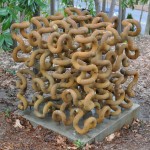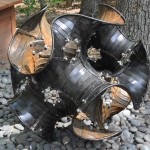Colm Mulcahy, of Spelman College in Atlanta, joins us to share his ice cream trick from his CardColm mathematical card trick column on the MAA website! You’re invited to explain how this works in the comments below.
Colm also shares a quick puzzle, tweeted on his What Would Martin Gardner Tweet feed @WWMGT. And finally we touch on the Gathering For Gardner and the Celebration of Mind, held all over the world around the time of Martin Gardner’s birthday, October 21.
And at last we get around to answering our quiz from a few weeks ago. There are indeed two solutions for correctly filling in the blanks in:
The number of 1’s in this paragraph is ___; the number of 2’s is ___; the number of 3’s is ____; and the number of 4’s is ___.
[spoiler] namely (3,1,3,1) and (2,3,2,1) [/spoiler]
We can vary this puzzle at will, asking
The number of 1’s in this paragraph is ___; the number of 2’s is ___; ….. and the number of N’s is ___.
For N=2 or 3, there are no solutions (Asking that all the numbers we fill in are between 1 and N); for N=4 there are two. For N=5 there is just one, for N=6 there are none and beyond that there is just one. I think we’ll let the commenters explain that.
But here’s the cool thing.
One way to approach the problem is to try filling in any answer at all, and then counting up what we have, filling that in, and repeating. Let’s illustrate, but first stipulate that we’ll stick with answers that are at least plausible– you can see that the total of all the numbers we fill in the blanks has to be 2N (since there are 2N total numbers in the paragraph).
So here’s how this works. Suppose our puzzle is:
There are ___ 1’s;___ 2’s; ___ 3’s; ___ 4’s; ___ 5’s
Let’s pick a (bad) solution that totals 10, say, (2,4,1,2,1). So we fill in:
There are __2_ 1’s; __4_ 2’s; _1__ 3’s; __2_ 4’s; _1__ 5’s
That’s pretty wrong! There are actually three 1’s in that paragraph, three 2’s; at least there is just one 3, and two 4’s and one 5. In any case this gives us another purported solution to try: (3,3,1,2,1). Let’s fill that in:
There are __3_ 1’s; __3_ 2’s; _1__ 3’s; __2_ 4’s; _1__ 5’s
That attempt actually does have three 1’s; but has only two 2’s; it does have three 3’s but only one 4 and one 5. So let’s try (3,2,3,1,1):
There are __3_ 1’s; __2_ 2’s; _3__ 3’s; __1_ 4’s; _1__ 5’s
Lo and behold that works! We do in fact have three 1’s; two 2’s; three 3’s and yes, one 4 and one 5.
So we can think of it this way: filling in a purported solution and reading off what we actually have gives another purported solution.
In this case (2,4,1,2,1) -> (3,3,1,2,1) -> (3,2,3,1,1) -> (3,2,3,1,1) etc,
We can keep following this process around, and if we ever reach a solution that gives back itself, we have a genuine answer, as we did here.
So here’s an interesting thing to think about.
First, find, for N>=7, a correct solution; and a pair of purported solutions A,B that cycle back and forth A->B->A->B etc.
Second, find a proof that this is all that can happen (unless I’m mistaken)– any other purported solution eventually leads into the correct one or that cycle.








 mathbun.com
mathbun.com